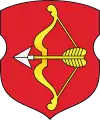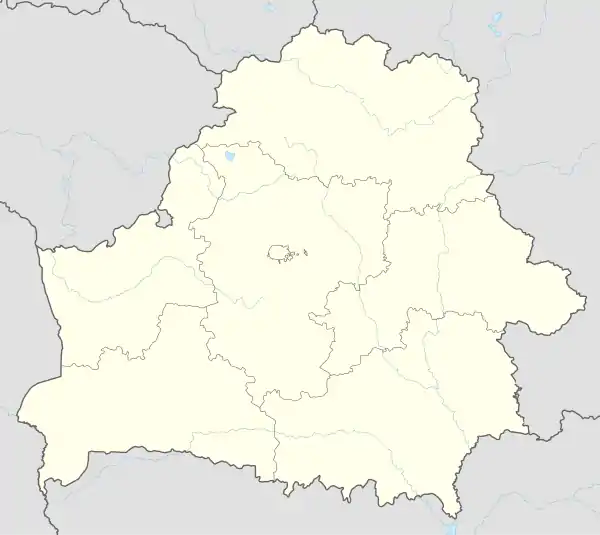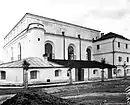Pinsk
Pinsk (Belarusian: Пі́нск; Russian: Пи́нск [pʲin̪s̪k]) is a city located in Brest Region of Belarus, in the Polesia region, at the confluence of the Pina River and the Pripyat River. The region was known as the Marsh of Pinsk and is southwest of Minsk. The population is 138,415.[2]
Pinsk
| |
|---|---|
.jpg.webp) | |
 Flag  Coat of arms | |
 Pinsk Location of Pinsk in Belarus | |
| Coordinates: 52°07′N 26°06′E | |
| Country | |
| Region | Brest Region |
| District | Pinsk District |
| Mentioned | 1097 |
| Area | |
| • Total | 51.48 km2 (19.88 sq mi) |
| Elevation | 141 m (463 ft) |
| Population (2013) | |
| • Total | 136,096 |
| [1] | |
| Time zone | UTC+3 (MSK) |
| Postal code | 225700, 225710, 225716, 225745 |
| Area code(s) | +375 165 |
| License plate | 1 |
| Website | Official website |
The historic city has a restored city centre, with two-story buildings from the 19th century and the early 20th century. The centre has become an active place for youths of all ages with summer theme parks and a new association football stadium, which houses the city's football club, FC Volna Pinsk.
History
Timeline up to WWI
- In the 9th and 10th centuries, the town of Pinsk was majority Lithuanian[3]
- 1097 - the first mention of Pinsk
- 1241 - transfer of the Orthodox diocese from Turov
- 1316 - after this date, Pinsk was incorporated into the Grand Duchy of Lithuania
- 1396 - a Catholic church and a Franciscan monastery were created
- 1523 - Pinsk becomes a royal city, first owned by Queen Bona
- 1569 - Pinsk becomes a seat of the poviat
- 1581 - king Stephen Báthory grants Pinsk city rights
- 1642-1646 - Saint Andrew Bobola stayed in the Jesuit monastery in Pinsk and nearby, conducting evangelistic activity
- 1648 - rebellion of the city and admission of Cossack forces under the command of Colonel Maxim Hładki. The slaughter of burghers not of the Orthodox religion. The assault of Janusz Radziwiłł's troops on the city, under the command of the hetman Hrehory Mirski of about 1200-1300 people, ended with the capture of the city. The city was burned to the ground and about 1/3 - 1/2 of the inhabitants were killed (it is estimated that on the eve of the Khmelnytsky Uprising, Pinsk had about 10,000 inhabitants)
- 1655 - Russians and Cossacks attacked the city and murdered many inhabitants.
- 1657 - in mid-May Zdanowicz's cossacks (about 2,000) destroyed the city and murdered many Roman Catholics. Jesuits, incl. Fr. Simon Maffon and Saint Andrew Bobola
- 1660 - Cossacks attacked Pinsk, robbed a Jesuit college and church, and murdered, among others Fr. Eustachy Piliński
- 1662 - return of the Jesuits to Pinsk, fire of the monastery after a year
- 1666 - foundation of the Dominican monastery
- 1690 - foundation of the Karolin settlement by Jan Karol Dolski
- 1695 - construction of a church and castle in Carolina by Michał Serwacy Wiśniowiecki
- 1706 - from May 5 to June 3. The capture of Pinsk by King of Sweden Charles XII. Blowing up the castle of Michał Serwacy Wiśniowiecki
- 1707 - the occupation of Pinsk by the army of General Halast and General Hołowina
- 1709–1710 and in 1716 - a great epidemic with thousands of victims
- 1717 - construction of the Bernardine monastery
- 1734 - construction of a Carmelite monastery
- 1756 - construction of the Mariavite Order [de] monastery
- 1767 - construction of the Ogiński Channel
- 1775 - construction of the Royal Canal
- 1793 - the Second Partition of the Commonwealth. Pinsk now belongs to Russian Empire.
- 1795 - establishment of the Catholic diocese of Pinsk (previously Pinsk was in the diocese of Lutsk)
- 1799 - the incorporation of Karolina into Pinsk
- 1796 - the liquidation of the Uniate diocese of Pinsk
- 1799 - liquidation of the Pinsk Catholic diocese (it was moved to Minsk)
- 1812 - in July, Pinsk was taken by Napoleon's army
- 1850 - a candle and soap factory was established
- 1882 - a railway line was brought from Żabinka and a match factory was opened
- 1885 - construction of a river shipyard in Leszcze
- 1907–1909 - a provincial circle of the Polish Education Association in Minsk operated in the city, which organized lectures on Polish literature and vocabulary, which, according to a report by the Russian police, "increased Polish national consciousness".
- 1909 - during the local elections 22 Russians, 7 Poles, 2 Jews and 1 representative of other nationalities were elected to the city council
- 1915 - Russian authorities abandon the city escaping from advancing German forces
WWI and Polish–Soviet War

Pinsk was occupied by the German Empire on 15 September 1915, during the First World War. After the German defeat, Pinsk became the subject of dispute between the Belarusian People's Republic and the Ukrainian People's Republic, both short-lived. Pinsk was taken by the advancing Red Army on 25 January 1919, during the Soviet westward offensive of 1918–19. It was retaken by Polish troops on 5 March 1919 during the Polish–Soviet War but was retaken by the Red Army on 23 July 1920 and finally retaken by the Polish on 26 September 1920. Pińsk became part of the reborn Poland in 1920 when the Polish-Soviet War ended with the Peace of Riga, signed in March 1921.[4]
Like many other cities in Eastern Europe, Pinsk had a significant Jewish population before World War II. According to the Russian census of 1897, out of the total number of 28,400 inhabitants, Jews were approximately 74% of the population (21,100 persons), making it one of the most Jewish cities under tsarist rule.[5] During the Polish-Soviet War, 35 Jewish civilians from Pinsk were executed by the Polish Army in April 1919 after being accused of collaborating with Russian Bolsheviks. The incident, known as the Pinsk massacre, created a diplomatic crisis noted at the Versailles Conference.[6]
Interwar period
Pińsk was the initial capital of the Polesie Voivodeship, but it moved to Brześć-nad-Bugiem (now Brest, Belarus) after a citywide fire on 7 September 1921. The population of the city grew rapidly in interwar Poland from 23,497 in 1921 to 33,500 in 1931. Pińsk became a bustling commercial centre, and 70% of the population was Jewish, in spite of considerable migration.[7][8]
Second World War
Following the Soviet invasion of Poland in 1939, Pinsk and the surrounding area was annexed to the Byelorussian Soviet Socialist Republic. It was the seat of the Pinsk Oblast from 1940.
After Operation Barbarossa, Germany occupied Pinsk from 4 July 1941 to 14 July 1944, as part of the Reichskommissariat Ukraine. Most Jews were killed in late October 1942 during the liquidation of the Pińsk Ghetto by the German Ordnungspolizei and the Byelorussian Auxiliary Police,[6] 10,000 being murdered in one day. In 1945, after postwar border adjustments of Poland, Pinsk again became part of the Byelorussian Soviet Socialist Republic.
Post-WWII: USSR; Belarus state
In 1954 it became part of the Brest Voblast.
Pinsk has formed part of the Republic of Belarus since Belarusian independence from the Soviet Union in 1991.
Landmarks
Three main sights of the town are lined along the river: the Assumption Cathedral of the Monastery of the Greyfriars (1712–1730), with a campanile from 1817, the Jesuit collegium (1635–1648); a large Mannerist complex, whose cathedral was demolished after World War II by communists; and the Butrymowicz Palace (1784–1790), built for Mateusz Butrymowicz, an important political and economical figure of Pinsk and Polesie. The Church of St. Charles Borromeo (1770—1782) and St. Barbara Cathedral of the Monastery of the St. Bernard Order (1786–1787) are placed near historic centre in the former Karolin suburb, which is now part of Pinsk. The foremost modern buildings is the black-domed Orthodox Cathedral of St. Theodore.
.jpg.webp) Old Market Square
Old Market Square.jpg.webp) Cathedral of St. Stanislaus and church of St. Dominic
Cathedral of St. Stanislaus and church of St. Dominic Cathedral of Name of the Blessed Virgin Mary
Cathedral of Name of the Blessed Virgin Mary Monastery of the Greyfriars
Monastery of the Greyfriars Jesuit collegium
Jesuit collegium Church of St. Charles Borromeo
Church of St. Charles Borromeo St. Barbara Cathedral
St. Barbara Cathedral St. Theodore Cathedral
St. Theodore Cathedral Old Synagogue
Old Synagogue Butrymowicz Palace
Butrymowicz Palace
Climate
| Climate data for Pinsk | |||||||||||||
|---|---|---|---|---|---|---|---|---|---|---|---|---|---|
| Month | Jan | Feb | Mar | Apr | May | Jun | Jul | Aug | Sep | Oct | Nov | Dec | Year |
| Record high °C (°F) | 10 (50) |
16 (61) |
21 (70) |
25 (77) |
30 (86) |
30 (86) |
32 (90) |
31 (88) |
28 (82) |
23 (73) |
14 (57) |
12 (54) |
32 (90) |
| Average high °C (°F) | −1 (30) |
−1 (30) |
4 (39) |
11 (52) |
18 (64) |
20 (68) |
22 (72) |
22 (72) |
17 (63) |
11 (52) |
3 (37) |
0 (32) |
11 (51) |
| Daily mean °C (°F) | −5.3 (22.5) |
−4.3 (24.3) |
−0.2 (31.6) |
7.2 (45.0) |
13.8 (56.8) |
16.9 (62.4) |
18.3 (64.9) |
17.2 (63.0) |
12.9 (55.2) |
7.1 (44.8) |
1.7 (35.1) |
−2.8 (27.0) |
6.9 (44.4) |
| Average low °C (°F) | −6 (21) |
−6 (21) |
−2 (28) |
3 (37) |
8 (46) |
11 (52) |
12 (54) |
12 (54) |
8 (46) |
3 (37) |
0 (32) |
−3 (27) |
3 (38) |
| Record low °C (°F) | −30 (−22) |
−24 (−11) |
−23 (−9) |
−10 (14) |
−2 (28) |
2 (36) |
6 (43) |
2 (36) |
−3 (27) |
−11 (12) |
−17 (1) |
−25 (−13) |
−30 (−22) |
| Average precipitation mm (inches) | 34 (1.3) |
32 (1.3) |
33 (1.3) |
44 (1.7) |
57 (2.2) |
74 (2.9) |
85 (3.3) |
69 (2.7) |
53 (2.1) |
49 (1.9) |
45 (1.8) |
42 (1.7) |
617 (24.2) |
| Source: [9] | |||||||||||||
Notable residents
- Bona Sforza, (1494-1557), Queen consort of Poland and Grand Duchess consort of Lithuania, Princess of Pinsk
- Adam Naruszewicz (1733–1796), Polish-Lithuanian poet, historian, bishop
- Matheus Butrymowicz (1745-1814), Polish-Lithuanian statesman, reformer of Polesye
- Aaron of Pinsk (died 1841), rabbi
- Napoleon Orda (1807-1883), Polish-Lithuanian musician, pianist, composer and artist
- Vintsent Dunin-Martsinkyevich, (1808-1884), Belarusian writer, poet, dramatist and social activist, author of play "Pinskaya shlyakhta"
- Helena Skirmunt (1827-1874), Polesian painter and sculptor
- Baruch Epstein (1860–1941), bookkeeper, rabbi and prolific Jewish scholar, best known for his Torah Temimah commentary on the Torah
- Ivan Zholtovsky (1867-1959), Soviet architect and educator
- Raman Skirmunt (1868-1939), Belarusian and Polesian statesman, aristocrat and landlord
- Chaim Weizmann (1874–1952), first president of Israel, born in Motal, near Pinsk and educated in Pinsk
- Sir Isaac Shoenberg (1880–1963), electrical engineer born in Pinsk, principal inventor of the first high-definition television system, as used by the BBC
- Leo Zeitlin (1884–1930), composer, born in Pinsk before studying in Odessa and later moving to the U.S.A.
- Golda Meir (1898–1978), fourth prime minister of Israel, born in Kiev, lived two years of her childhood in Pinsk
- Simon Kuznets (1901–1985), 1971 Nobel laureate in economics
- Theodore Odrach (1912-1964), Ukrainian and Polesian writer of novels, short stories and memoirs
- Kazimierz Świątek (1914-2011), Cardinal of the Roman Catholic Church, Metropolitan Archbishop of Minsk-Mohilev and Apostolic Administrator of Pinsk
- Semyon Furman (1920–1978), Chess grandmaster and trainer of World Champion Anatoly Karpov
- Ryszard Kapuściński (1932–2007), Polish writer and reporter
- Yauhen Shatokhin (1947-2012), Belarusian painter and political activist
- Chaim Kanievsky (1928–), rabbi
- Izya Shlosberg (1950–), Jewish American artist, born in Pinsk and lived in Pinsk for 44 years
- William Moses Feldman, child physiologist, born in Pinsk
- parents of Ralph Lauren, American fashion designer lived in Pinsk before moving to the U.S.A
- Vladimir Chub (1948–), governor of Rostov Oblast in Russia
- Igor Kolb (1977?–), principal dancer of Mariinsky Ballet
- Olga Govortsova, (1988–) Belarusian tennis player
- Andrzej Kondratiuk (1936–2016), Polish film director, screenwriter, actor, and cinematographer
- Sławomir Rawicz (1915–2004), Polish Army lieutenant, claimed to have walked from Siberia to India during World War II
References
- "Belarus - The regions of the Republic of Belarus as well as all cities and urban settlements of more than 10,000 inhabitants". City Population. Retrieved 2014-04-11.
- "Пинск попал в десятку крупнейших городов Беларуси" (in Russian). Retrieved 2020-11-11.
- Greenbaum, Masha (1995). The Jews of Lithuania: A History of a Remarkable Community 1316-1945. Jerusalem: Gefen. p. 2. ISBN 9789652291325.
- Norman Davies (2003). White Eagle, Red Star: the Polish-Soviet War, 1919–20. Pimlico. p. 399. ISBN 0-7126-0694-7. (First edition: New York, St. Martin's Press, inc., 1972.)
- Joshua D. Zimmerman (2004), Poles, Jews, and the Politics of Nationality. University of Wisconsin Press, ISBN 0-299-19464-7, Google Books preview, p. 16.
- Best of the memory books, Marcin Wodzinski, Haaretz, Books, February 2009, pp. 28–30
- PAT MF.271 (1936). "Original film footage: "In the land of rivers and bogs" newsreel chronicle" [W krainie rzek i moczarów]. Sygnatura: MF.271 Data wydania: 1936. Czas trwania: 00:01:16.
- Cezary Rudziński (2017). "History of Pinsk in the Borderlands" [Pińsk. O dziejach kresowego miasta]. Otwarty Przewodnik Krajoznawczy.
- weatherbase.com—http://www.weatherbase.com/weather/weather.php3?s=91033]. Retrieved 29 November 2017.
Further reading
- Mordechai Nadav (2008) The Jews of Pinsk, 1506–1880; edited by Mark Jay Mirsky and Moshe Rosman; translated by Moshe Rosman and Faigie Tropper. Stanford, Calif: Stanford University Press,
- (in Belarusian, Russian and English) T. A. Khvagina (2007) Pinsk and its surroundings, Minsk Vysheysha shkola, ISBN 978-985-06-1419-3,
- (in Belarusian, Russian and English) T. A. Khvagina (2004) Pinsk: A Fairy Tale of Polessye, Minsk Vysheysha shkola, ISBN 985-06-0836-6,
- (in Belarusian, Russian and English) T. A. Khvagina (2005) POLESYE from the Bug to the Ubort, Minsk Vysheysha shkola, ISBN 985-06-1153-7.
External links
| Wikimedia Commons has media related to Pinsk. |
- Yad Yisroel - Pinsk
- Jewish Community in Pinsk on Virtual Shtetl
- Photos on Radzima.org
- "The city of Pinsk, Belarus" by Tatyana Khvagina and Oleg Babinets
- "Pinsk", Jewish Encyclopedia
- Images of the Assumption Cathedral
- Image of the Jesuit Collegium
- Virtual Guide to Belarus: Pinsk
- News from Pinsk
- Pinsk, Belarus at JewishGen
